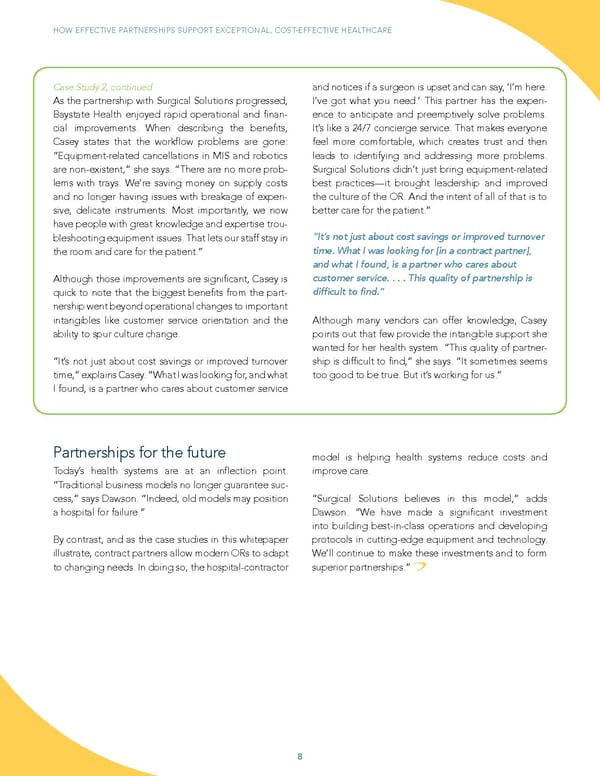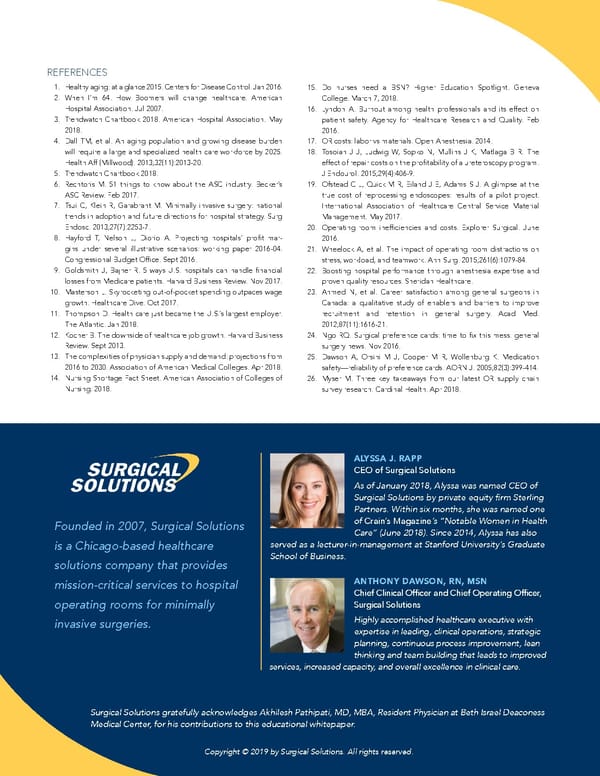Surgical Solutions White Paper
How Effective Partnerships Support Exceptional, Cost-Effective Healthcare The Role of Contract Partners in Helping Hospitals Adapt to a Changing Healthcare System WHITEPAPER

This is a modal window.
AMERICAN HEALTHCARE IS UNDERGOING dementia, and other chronic diseases will more than A TRANSFORMATION. Changing demographics, double by 2050. The prevalence of acute medical technological development, and new policy measures issues will also rise. For example, each year a third of have all affected the way we deliver and pay for care. adults over the age of 65 fall and sustain injuries. The Perhaps nowhere are those changes more evident than American Hospital Association (AHA) projects more 2 in the practice of surgery. Operating rooms have long than half a million hip fractures per year by 2050. been a major source of revenue for healthcare provid- ers. Yet as the economics of healthcare shift, health sys- The trend toward higher demand for healthcare is tems have experienced shrinking margins. already underway. There were 750 million doctor’s visits 3 in 2016, up from 380 million in 1994. A recent study pro- Today’s hospital leaders and managers are faced with jected an 8% to 12% further increase in outpatient visits 4 the challenge of how to leverage new opportunities, and nearly 20% more inpatient hospital days by 2025. mitigate risk, and ensure the delivery of cost-effective care. One solution is to use third-party service provid- A growing disease burden has come with a corre- ers. A growing number of hospitals have established sponding increase in the need for surgery. The number of outside contracts for functions like clinical staffing and surgeries performed in the US grew by 17% in the last supply chain management. Although outsourcing is two decades, the majority of which were performed 5 not a revolutionary business strategy, its application to on patients over the age of 65. Surgical specialties are perioperative services represents a strategic and adap- expected to see some of the largest increases in demand. tive framework for hospitals to improve both patient care and their bottom lines. The number of surgeries performed in This whitepaper explores key benefits of partnering with the US grew by 17% in the last two vendors by identifying four key trends affecting hospital decades, the majority of which were performance and by analyzing how third-party service performed on patients over the age providers can help hospitals adapt to those trends. The of 65. findings reflect the experience at two health systems, Erlanger Health System and Baystate Health, where healthcare teams benefited from implementing con- tract service solutions, the results of which are profiled Trend #2: Surgical care is increasingly outpatient as case studies in this whitepaper. and minimally invasive Higher surgical volume has been accompanied by Four key trends affecting the changing techniques. Procedures that once required lengthy hospital stays can now be done on an outpa- performance of healthcare systems tient basis. The number of annual outpatient proce- dures grew over 40% between 1990 and 2014, and the Trend #1: An aging population will spur increased proportion increased from roughly half to two-thirds of demand for healthcare services all surgeries.6 It is well documented that the US has an aging pop- ulation. The Census Bureau projects that the number One of the biggest drivers of this transition has been of people over the age of 65 will double by 2060 and the development of endoscopes for minimally invasive account for more than one-quarter of the population. surgery (MIS). Scopes allow surgeons to gain an internal The number over the age of 85 will grow by over 200% view of the body with a camera, precluding the need for in the same time frame.1 a large incision and direct view. An older population will inevitably have higher health Cholecystectomies are a paradigmatic example. needs. The number of Americans with diabetes, Remov ing the gallbladder was once an open procedure 1
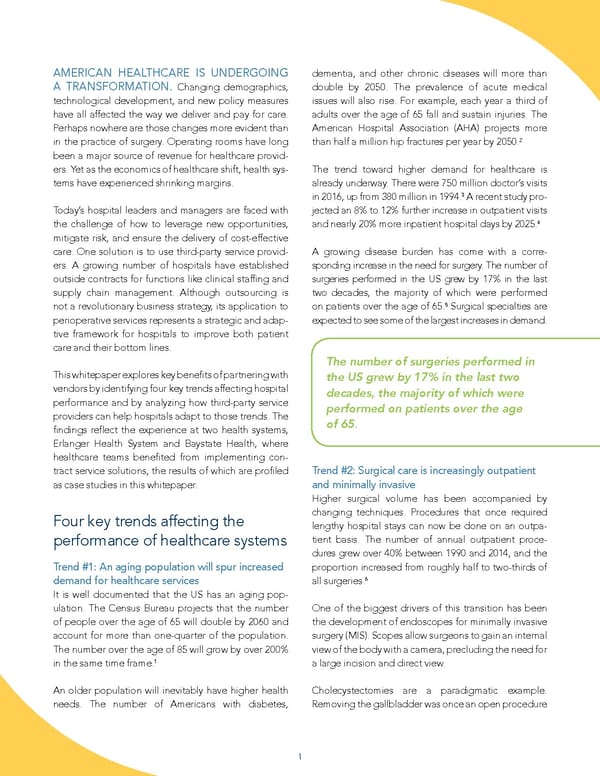
HOW EFFECTIVE PARTNERSHIPS SUPPORT EXCEPTIONAL, COST-EFFECTIVE HEALTHCARE 8 necessitating a multiday hospital course and significant 2025 if they remain at their current level of productivity. pain management. With the development of new tech- Furthermore, the causes underlying hospital struggles nology, more than 95% of cholecystectomies are now may worsen in coming years. laparoscopic and a large majority of patients go home 7 on the day of their surgery. Endoscopy is widely used Several policy measures have contributed to hospitals’ in general surgery, orthopedics, gastroenterology, and financial outlook. These include requirements for costly otolaryngology, among other specialties. IT infrastructure, new outcomes tracking and reporting obligations, and reductions in Medicare reimburse- The transition to MIS has important implications for ments as part of the growing emphasis on value-based both patient care and hospital operations. From a care, which ties payments to quality measures. AHA patient perspective, MIS has led to lower complication data shows that hospitals have an average margin of 9 rates, shorter hospital stays, reduced blood loss, and negative 10% on Medicare patients. Ongoing cuts to better functional status. There is little question that Medicare and Medicaid payments and instability in increased utilization can improve patient outcomes. the individual insurance market will exacerbate these losses. Minimally invasive surgery has led to A closely related financial challenge is the evolution lower complication rates, shorter of hospitals’ payer mix. As an aging population spurs hospital stays, reduced blood loss, increased patient volume, hospitals will see a higher and better functional status. There is proportion of Medicare patients. Declining reimburse- little question that increased utilization ments make it difficult for hospitals to recoup costs associated with their care. At the same time, many can improve patient outcomes. commercially insured patients are migrating toward high-deductible health plans. The average deductible for employer-based health plans rose from roughly $300 The effect of this transition on health systems is more in 2006 to more than $1,500 in 2017.10 As patients bear nuanced, and the shift from hospital operating rooms higher out-of-pocket costs, hospitals will see higher lev- to outpatient settings has broad implications. On els of bad debt from unpaid medical bills. the one hand, it enables higher patient throughput, decreases the cost of surgery, and creates additional Hospitals face rising operating costs as well. Two inpatient capacity for sicker patients. On the other expenses stand out: technology and labor. By some hand, it has spurred hospital investment in outpatient estimates, new technology accounts for half of the surgical capacity. annual growth in American healthcare spending. Of course, technological development is crucial to improv- However, reimbursements for outpatient surgery are ing patient care. The minimally invasive surgeries lower than their inpatient equivalents and further vary discussed above are only possible because of improve- based on a facility’s designation as an ambulatory sur- ments in radiological imaging, new endoscopes, and gery center or hospital outpatient department. As a a host of other innovations. Even so, it is expensive for result, hospitals must balance gains and losses associ- hospitals to continually invest in new products. ated with different surgical settings. Finally, labor is most hospitals’ single largest expense. Trend #3: Health systems are under financial The healthcare industry became the largest source pressure due to policy changes, an evolving payer of jobs in the US in 2017, and there is little reason to mix, and rising operating expenses believe its growth will slow.11 Notably, most of this Hospital operating margins are nearing all-time lows. An growth has been due to rising numbers of adminis- analysis by the Congressional Budget Office found that trators and clerical workers rather than clinical staff.12 a majority of US hospitals will have negative margins by This suggests growing labor expenses stem from 2
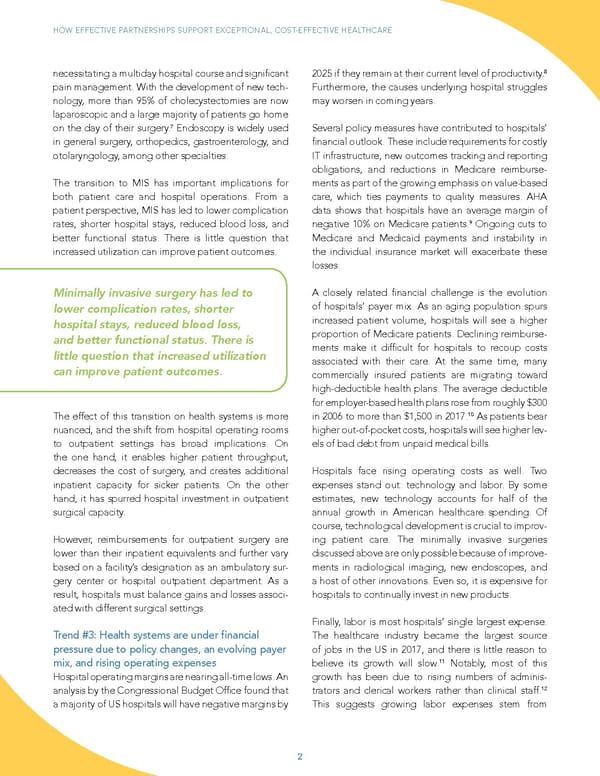
HOW EFFECTIVE PARTNERSHIPS SUPPORT EXCEPTIONAL, COST-EFFECTIVE HEALTHCARE administrative burdens and the increasingly complex Top three ways contracted services business of medicine rather than improved patient care position operating rooms for or clinical capacity. Trend #4: Health systems face physician and nurse success in this environment staffing shortages Hospitals have responded to changes in healthcare Despite increased spending on labor, hospitals are with diverse solutions. One of the most common has struggling to maintain appropriate levels of clinical been to get bigger. Hospitals and physician prac- staff. This is in large part because of a limited supply. tices are consolidating into large health systems at The Association of American Medical Colleges proj- a rapid pace. The resulting scale allows them to lock 13 ects a shortage of 120,000 physicians by 2030, and in patients and negotiate better prices with payers. the American Association of Colleges of Nursing esti- More creative strategies include expansion of tele- 14 mates over 1 million nursing job openings by 2024. medicine and investments in preventive, “high-touch” The existing nursing workforce is also facing changing medicine. standards in training. The Institute of Medicine issued a report in 2010 calling for 80% of nurses to have at These approaches are meaningful. Another, more spe- least a bachelor’s degree by 2020. At the time of the cific approach is to target an enormous source of cost report’s release, about 50% of the nursing workforce and revenue: the operating room. On average, ORs had a BSN. Recent estimates indicate that only 55% account for 30% to 50% of a hospital’s expenses and 15 17 to 60% of nurses have a BSN. The push for nurses to 60% to 70% of its revenues. With ballooning surgical obtain four-year degrees will restrict the supply further. volume and rapid advances in operative technology, there is little doubt the OR will continue to command Staffing shortages are complicated by an epidemic of the lion’s share of hospital balance sheets and play an burnout among caregivers. Surveys show rates as high outsized role in patient outcomes. as 50% in physicians and 70% in nurses.16 Of note, staff- ing shortages are both a cause and consequence of As a result, ORs are particularly sensitive to the trends burnout. When there are not enough providers, health described above. OR leaders and managers must find systems place additional responsibilities on the peo- ways to schedule more cases with an ever-changing ple they already have, decreasing job satisfaction. The surgical toolkit amid shrinking budgets and workforce decrease in satisfaction leads employees to quit, ampli- shortages. Efficiency is crucial in this environment. An fying the shortage and creating a vicious cycle. increasing number of health systems have therefore turned to third-party service providers who can stream- line processes and maximize throughput. This approach Staffing shortages decrease the has potential for three key reasons. capacity, efficiency, and effectiveness #1: Contracting OR services saves money by of a health system. converting fixed costs into variable costs Operating rooms are expensive. They require invest- ment in core infrastructure like OR tables, lights, The effects of physician and nursing shortages are and booms, as well as clinical tools like anesthesia self-explanatory. They cause delays in patient care, machines and surgical instruments. In addition to increase rates of medical error, and decrease patient obtaining inventory, hospitals must allocate a budget satisfaction. They also lead to higher rates of employee to maintain it. Finally, ORs require a well-trained, multi- attrition, raising the cost of recruiting and retaining staff disciplinary staff with accompanying payroll expenses. (sometimes by millions of dollars). Staffing shortages In other words, ORs face the same cost pressures decrease the capacity, efficiency, and effectiveness of that challenge health systems as a whole: technology a health system. and labor. 3
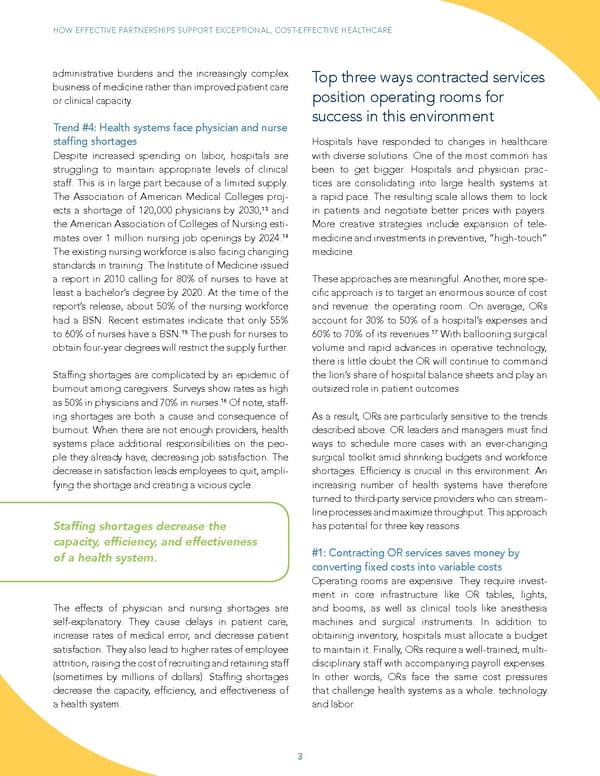
HOW EFFECTIVE PARTNERSHIPS SUPPORT EXCEPTIONAL, COST-EFFECTIVE HEALTHCARE The rise of MIS is illustrative. As an innovative surgical costs. Instead of making large investments in technol- modality that improves patient outcomes, health sys- ogy and training that may offer little return, they can tems need to invest in endoscopes and other tools that map costs directly to volume. In doing so, they elimi- enable MIS. Scopes alone can cost $10,000 and are in nate repair and replacement costs, protect the financial some cases upwards of $30,000. health of the OR, and still maintain the ability to provide cutting-edge care. Maintenance, repairs, and replacement of scopes add tens of thousands of dollars of expenses per year, with #2: Physicians and nurses are enabled to perform the cost increasing as inventory ages. A 2015 study at the top of their license, increasing OR efficiency found that a community hospital spent $115,000 in one and provider satisfaction 18 year exclusively on ureteroscope repair. Extrapolating One consequence of provider shortages is that phy- that to a full suite of endoscopic procedures could add sicians and nurses are forced to do incremental tasks up to expenditures in the millions. beyond their designated responsibilities. Surgeons increasingly participate in operating room turnover, Meanwhile, endoscopy requires expert personnel. equipment troubleshooting, and other work tradition- Although the most obvious example is the surgeon, ally done by support staff. a team of nurses and technicians are responsible for patient monitoring, documentation, and technical Perioperative nurses face growing non-clinical duties assistance. Simply preparing and reprocessing an endo- as well, many of which are associated with equipment. 19 scope for a new case takes an average of 76 minutes. A recent analysis found that 58% of nurse out-of-room Hospitals must therefore recruit and train staff to meet time was spent retrieving supplies.20 Another study pub- those needs despite the thin labor market. lished in the Annals of Surgery found that equipment issues were the most “intense” source of distraction in 21 Yet all of this invested capital can quickly become the OR and significantly increased nurse stress levels. obsolete. Returning to the example of laparoscopic cholecystectomy, there has been a proliferation of new Time that surgeons and nurses spend on workflow and techniques in the last decade. These include the devel- logistics is time away from operating and patient care. opment of “mini” and “micro” laparoscopy, single-inci- Staff are also less effective in their non-core functions. sion cholecystectomy, robotic surgery, and transluminal A nurse who needs to manage malfunctioning equip- endoscopy (in which there is no external incision). ment will inevitably be slower than a supply techni- cian. This is a drag on OR productivity and a driver of These advances are a boon for patients. But for a hos- increased costs. pital trying to keep up with the latest developments in surgery, it means writing off older technology, mak- Contract service providers boost OR efficiency by ing expensive new purchases, and retraining staff on shifting responsibilities to specialists and allowing how to work with different tools. In an environment caregivers to focus on care. For instance, one hospi- of shrinking operating margins, this type of spending tal increased case volume by 40% (more than 250 sur- is unsustainable. geries per month) by outsourcing anesthesia services, and it achieved these results without having to hire any 22 Contracted service providers address the problem by new staff. sharing risk and expanding hospital balance sheets. For instance, many health systems (including Erlanger Added benefits are improved morale and decreased Health System, profiled in a case study that appears rates of burnout. Surveys show that surgeons are happi- later in this whitepaper) now outsource MIS scope est when they do not have to worry about OR manage- 23 provision, upgrades, repair, and technical support. The ment and can focus on patients. The same is true of hospital pays a flat fee per surgery for these services. nurses. Offloading logistical burdens in the OR allows This model allows health systems to variabilize fixed clinical staff to practice at the top of their license. 4
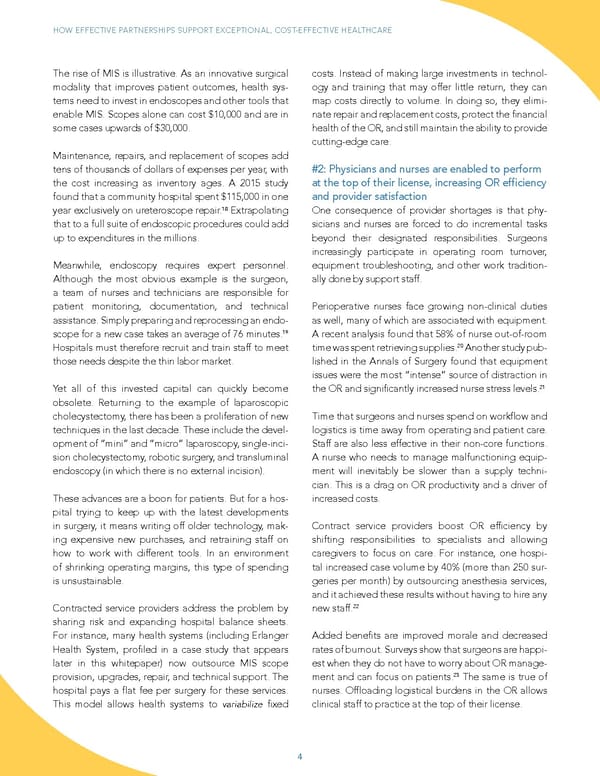
HOW EFFECTIVE PARTNERSHIPS SUPPORT EXCEPTIONAL, COST-EFFECTIVE HEALTHCARE #3: Effective partnerships enable superior patient care SURGICAL SOLUTIONS SERVICES AT A GLANCE Contracting select OR services does not just affect costs, case volume, and satisfaction; it can improve overall sup- To help your facility improve financial/operational ply chain management and enhance a health system’s performance and physician satisfaction with quality of care. Consider the example of surgeon prefer- better OR management and greater efficiency, ence cards. Although they tacitly represent the supplies Surgical Solutions’ customized programs include: a surgeon needs in a case, many surgeons are unaware of what is on their own cards. In one survey, more than 80% of surgeons and 70% of nurses expressed concern Expert handling of scopes and instrumentation 24 with preference card management. by highly experienced team members Discrepancies have a tangible effect on patient out- Our CRCST technicians are on hand for every comes. An analysis at NewYork-Presbyterian Hospital case. They’re accountable for: investigated how preference cards influence medication Pre-, intra-, and post-procedure technical 25 safety. Cards listed an average of five medications, but support over 85% of the medications did not have any instruc- SPD, decontamination, prep and pack tions on dosing or preparation. More than 75% of cards used brand and generic names interchangeably, and in some cases the names did not match. The authors Repair maintenance management concluded that preference cards were a notable risk for medication errors in the OR. Surgical Solutions assumes the logistical pro- Broader supply chain issues delay care, prolong patients’ cess and cost of: time under anesthesia, and increase complication rates Instrument and scope repairs and dispos- when surgeons operate with the wrong tools. A 2018 ables for lap aroscopic procedures (e.g, study found that 67% of providers had moments when trocars, cannulas, etc.) the right supplies were not on hand during a procedure, Maintaining your contractual requirements 40% had canceled cases, and over 25% had patients with for rebates through trace sales reporting 26 an adverse outcome because of the supply chain. Contract partners cannot resolve every problem. In fact, Access to capital a poorly planned outsourcing strategy may create more problems than it solves because of a lack of standardiza- Deliver the instrumentation and equipment tion and diffusion of responsibility. Lack of standardiza- to support all scope procedures in the OR tion and optimized workflows creates an environment and endo suites of uncertainty, often resulting in delays and patient and Acquire physician-preferred disposables and staff dissatisfaction, according to Anthony Dawson, equipment RN, MSN, Chief Clinical Officer and Chief Operating Officer at Surgical Solutions, LLC, in Chicago, Illinois. All services and products by Surgical Solutions Conversely, a terrific contract partner can streamline are charged on a price-per-case basis, trans- processes and drive efficiency and throughput gains for forming your fixed costs into variable costs. a hospital or system. “Demographic and technological changes present Click here oppor tunities, but health systems can lack the bandwidth for a free on-site assessment to see to take advantage of them,” says Dawson. “Contract how efficient your facility can really be. 5
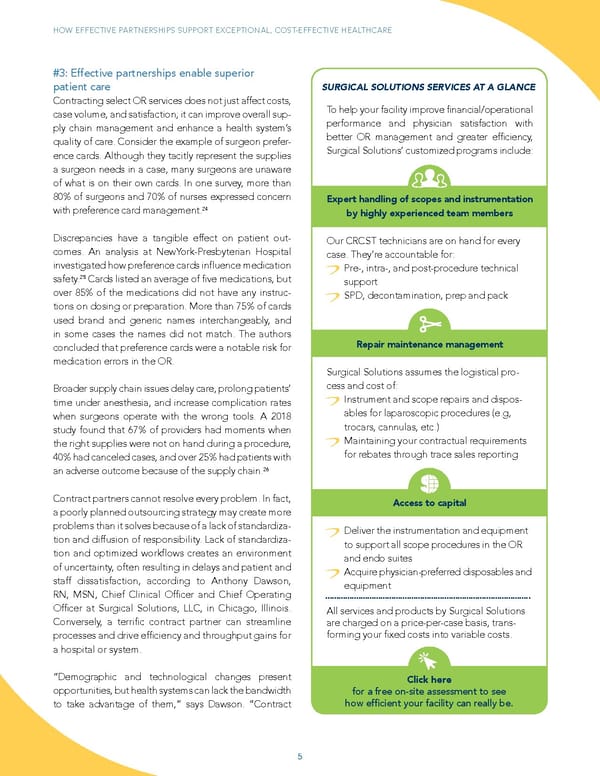
HOW EFFECTIVE PARTNERSHIPS SUPPORT EXCEPTIONAL, COST-EFFECTIVE HEALTHCARE partners like Surgical Solutions create value by helping room, central sterile supply, materials management, systems consolidate and standardize strategic targets. and biomedical engineering. A strategic, collaborative We provide a comprehensive suite of services for preop, approach transforms the health systems we work with intraop, and postop by expertly addressing bottlenecks by limiting errors in the OR and SPD and ensuring that and gaps in service that exist between the operating patients receive the best possible care.” CASE STUDY 1 How Erlanger Health System used strategic partnerships to enable growth ERLANGER HEALTH SYSTEM’S EXPERIENCE highlights competitive, and also investment to keep what we the opportunities that contract partners can create. have running,” says Royer. “One of the errors health- Erlanger is a major institution in Chattanooga, care organizations make is putting all their money into Tennessee. It has over 900 beds across seven hospitals, strategic planning or all into replacement capital. If you including a level 1 trauma center, a children’s hospital, focus on one, you’re dying on the vine on the other.” and two critical access hospitals. It serves more than 800,000 patients annually, while also participating in Second, resources were getting pulled in multiple research and education as an affiliate of the University directions. For example, staff sometimes took respon- of Tennessee College of Medicine in Chattanooga. sibility for fulfilling needs in different surgical areas, which in turn affected workflow. In 2013, the system embarked on a major growth effort. Hospital leadership identified surgery as one strategic After extensive discussion, Erlanger’s leaders decided target. “We wanted to provide as much access to our contract services could help the system achieve its goals. services as possible,” explains Britt Tabor, Executive “Vendors can fill a void in several ways,” says Tabor. “They Vice President and Chief Financial Officer of Erlanger. can add competence or expertise in a new domain, they “An important part of that was offering and supporting can bring in people we might not attract on our own, and procedures that patients needed close to home.” they might have scalability or market access that reduces costs. We had to look at all of the possibilities and see The initiative was led by Adam Royer, Assistant Vice what made the most sense for our specific issues.” President of Surgical Services, who had broad over- sight over quality, strategy, finance, and operations for Erlanger evaluated several vendors and contracted the health system’s 50 operating rooms. Royer’s team with Surgical Solutions, LLC, to offer minimally invasive defined goals around cost, efficiency, and quality. They surgical support services. Surgical Solutions provided had seen steady progress over the past several years a bundled package of technicians, capital equipment but saw opportunities for further improvement. leasing and repairs, and disposable instrumentation. The service included preop room setup, intraop sup- According to Royer, two issues stood out. First, the sur- port, and postop room breakdown as well as instru- gery department faced a dual challenge of maintaining ment inspection, transportation, and decontamination existing capital equipment while simultaneously invest- (in conjunction with the hospital’s sterile processing ing in the future. “It was difficult to balance funding for department). both strategic investment that keeps the organization continues > 6

HOW EFFECTIVE PARTNERSHIPS SUPPORT EXCEPTIONAL, COST-EFFECTIVE HEALTHCARE Case Study 1, continued to Royer, the service contract made surgery faster and As Royer describes the rollout, “Like any new thing, more predictable and reduced OR turnover time. there was apprehension when we started. No one knew what to expect. But it worked out well. Now the right “We got better at maximizing resources—bringing person has responsibility for the right tasks. It freed our in new equipment, shuffling items between locations, staff to be more patient focused.” and making the most of them,” says Jeff Loy, Assistant Vice President of Supply Chain at Erlanger. “With fees “Establishing [a contract service] model allows based on utilization, there was a shared benefit from two organizations to co-invest in a common vision. increasing surgical capacity.” The efforts paid off with The future of healthcare is in long-term strategic bell-curve growth. partnerships.” In reflecting on Erlanger’s success, Royer highlights that Erlanger physicians, nurses, and technicians saw several the contract service model works because it is much benefits, including efficiency in the ORs and cost bene- more than a simple hospital-vendor contract—it is a fits in the new contract. The service contract eliminated partnership with aligned incentives and shared goals. repair costs, dramatically reduced spending on capital “Establishing this model allows two organizations to expenses, and ensured loaner equipment was on hand if co-invest in a common vision,” says Royer. “The future there was breakage. Perhaps most importantly, according of healthcare is in long-term strategic partnerships.” CASE STUDY 2 How Baystate Health used strategic partnerships to improve OR efficiency and culture BAYSTATE HEALTH IS A LARGE, INTEGRATED health sys Casey says. “Occasionally, a case would get canceled tem in western Massachusetts. It includes five hospi- because equipment wasn’t ready or a tray wasn’t com- tals with nearly 1,000 beds, including the region’s only plete. Those problems create added costs when you level 1 trauma center. It treats more than 800,000 unnecessarily open extra trays.” patients annually and performs over 36,000 surgeries in its 56 operating rooms each year. It also conducts With over 30 years of experience managing surgical research and education as a teaching hospital for the services, Casey knew that hospitals had a broad toolkit University of Massachusetts Medical School. available to address these challenges, including con- tract partners. She had previously worked with several When Elizabeth Casey joined the system as Vice vendors and chose to bring in one of her preferred President of Surgical Services in 2017, she observed a partners, Surgical Solutions, to provide services for familiar set of challenges in the OR. Like many hospitals, minimally invasive and robotic surgery, including equip- Baystate needed to balance surgical efficiency, quality, ment, personnel, room setup and breakdown, and ster- and costs. “We sometimes had problems with turn- ile processing support. over time and first case start times getting delayed,” continues > 7
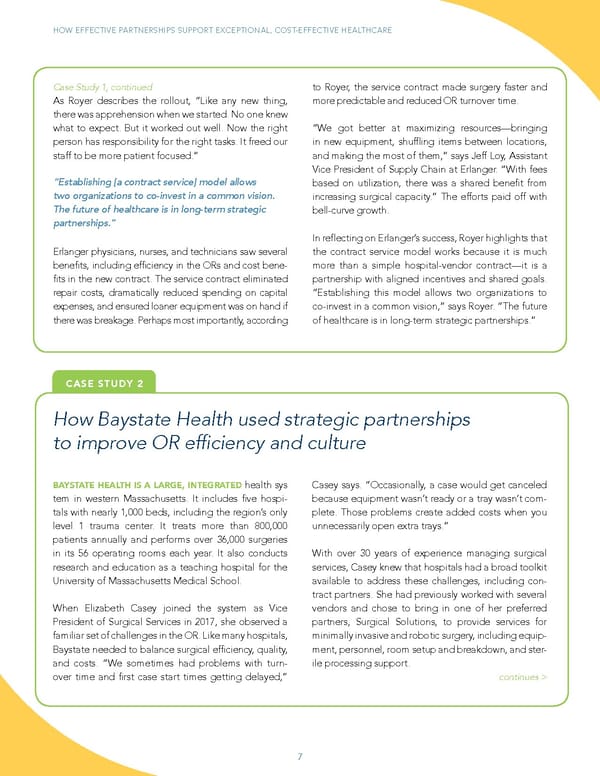
HOW EFFECTIVE PARTNERSHIPS SUPPORT EXCEPTIONAL, COST-EFFECTIVE HEALTHCARE Case Study 2, continued and notices if a surgeon is upset and can say, ‘I’m here. As the partnership with Surgical Solutions progressed, I’ve got what you need.’ This partner has the experi- Baystate Health enjoyed rapid operational and finan- ence to anticipate and preemptively solve problems. cial improvements. When describing the benefits, It’s like a 24/7 concierge service. That makes everyone Casey states that the workflow problems are gone: feel more comfortable, which creates trust and then “Equipment-related cancellations in MIS and robotics leads to identifying and addressing more problems. are non-existent,” she says. “There are no more prob- Surgical Solutions didn’t just bring equipment-related lems with trays. We’re saving money on supply costs best practices—it brought leadership and improved and no longer having issues with breakage of expen- the culture of the OR. And the intent of all of that is to sive, delicate instruments. Most importantly, we now better care for the patient.” have people with great knowledge and expertise trou- bleshooting equipment issues. That lets our staff stay in “It’s not just about cost savings or improved turnover the room and care for the patient.” time. What I was looking for [in a contract partner], and what I found, is a partner who cares about Although those improvements are significant, Casey is customer service. . . . This quality of partnership is quick to note that the biggest benefits from the part- difficult to find.” nership went beyond operational changes to important intangibles like customer service orientation and the Although many vendors can offer knowledge, Casey ability to spur culture change. points out that few provide the intangible support she wanted for her health system. “This quality of partner- “It’s not just about cost savings or improved turnover ship is difficult to find,” she says. “It sometimes seems time,” explains Casey. “What I was looking for, and what too good to be true. But it’s working for us.” I found, is a partner who cares about customer service Partnerships for the future model is helping health systems reduce costs and Today’s health systems are at an inflection point. improve care. “Traditional business models no longer guarantee suc- cess,” says Dawson. “Indeed, old models may position “Surgical Solutions believes in this model,” adds a hospital for failure.” Dawson. “We have made a significant investment into building best-in-class operations and developing By contrast, and as the case studies in this whitepaper protocols in cutting-edge equipment and technology. illustrate, contract partners allow modern ORs to adapt We’ll continue to make these investments and to form to changing needs. In doing so, the hospital-contractor superior partnerships.” 8
REFERENCES 1. Heal thy aging: at a glance 2015. Centers for Disease Control. Jan 2016. 15. Do nurses need a BSN? Higher Educat ion Spotlight. Geneva 2. When I’m 64. How Boomers wil l change healthcare. American College. March 7, 2018. Hospital Association. Jul 2007. 16. L yndon A. Burnout among health professionals and its effect on 3. T rendwatch Chartbook 2018. American Hospital Association. May patient safety. Agency for Healthcare Research and Quality. Feb 2018. 2016. 4. Dal l TM, et al. An aging population and growing disease burden 17. OR costs: labor vs materials. Open Anesthesia. 2014. will require a large and specialized health care workforce by 2025. 18. T osoian J J, Ludwig W, Sopko N, Mullins J K, Matlaga B R. The Health Aff (Millwood). 2013;32(11):2013-20. effect of repair costs on the profitability of a ureteroscopy program. 5. Trendwatch Chartbook 2018. J Endourol. 2015;29(4):406-9. 6. Rechtoris M. 51 t hings to know about the ASC industry. Becker’s 19. Ofstead C L, Quick M R, Eiland J E, Adams S J. A gl impse at the ASC Review. Feb 2017. true cost of reprocessing endoscopes: results of a pilot project. 7. T sui C, Klein R, Garabrant M. Minimally invasive surgery: national International Association of Healthcare Central Service Material trends in adoption and future directions for hospital strategy. Surg Management. May 2017. Endosc. 2013;27(7):2253-7. 20. Operat ing room inefficiencies and costs. Explorer Surgical. June 8. Hayfor d T, Nelson L, Diorio A. Projecting hospitals’ profit mar- 2016. gins under several illustrative scenarios: working paper 2016-04. 21. Wheelock A, et al. The impact of operating room distractions on Congressional Budget Office. Sept 2016. stress, workload, and teamwork. Ann Surg. 2015;261(6):1079-84. 9. Goldsmit h J, Bajner R. 5 ways U.S. hospitals can handle financial 22. Boost ing hospital performance through anesthesia expertise and losses from Medicare patients. Harvard Business Review. Nov 2017. proven quality resources. Sheridan Healthcare. 10. Masterson L. Skyr ocketing out-of-pocket spending outpaces wage 23. Ahmed N, et al. Car eer satisfaction among general surgeons in growth. Healthcare Dive. Oct 2017. Canada: a qualitative study of enablers and barriers to improve 11. Thompson D. Heal th care just became the U.S.’s largest employer. recruitment and retention in general surgery. Acad Med. The Atlantic. Jan 2018. 2012;87(11):1616-21. 12. Kocher B. The downside of healthcare job growth. Harvard Business 24. Ngo RQ. Surgical preference cards: time to fix this mess. general Review. Sept 2013. surgery news. Nov 2016. 13. The complexit ies of physician supply and demand: projections from 25. Dawson A, Orsini M J, Cooper M R, W ollenburg K. Medication 2016 to 2030. Association of American Medical Colleges. Apr 2018. safety—reliability of preference cards. AORN J. 2005;82(3):399-414. 14. Nursing Shortage Fact Sheet. American Associat ion of Colleges of 26. Myser M. Thr ee key takeaways from our latest OR supply chain Nursing. 2018. survey research. Cardinal Health. Apr 2018. ALYSSA J. RAPP CEO of Surgical Solutions As of January 2018, Alyssa was named CEO of Surgical Solutions by private equity firm Sterling Partners. Within six months, she was named one Founded in 2007, Surgical Solutions of Crain’s Magazine’s “Notable Women in Health Care” (June 2018). Since 2014, Alyssa has also is a Chicago-based healthcare served as a lecturer-in-management at Stanford University’s Graduate solutions company that provides School of Business. mission-critical services to hospital ANTHONY DAWSON, RN, MSN Chief Clinical Officer and Chief Operating Officer, operating rooms for minimally Surgical Solutions invasive surgeries. Highly accomplished healthcare executive with expertise in leading, clinical operations, strategic planning, continuous process improvement, lean thinking and team building that leads to improved services, increased capacity, and overall excellence in clinical care. Surgical Solutions gratefully acknowledges Akhilesh Pathipati, MD, MBA, Resident Physician at Beth Israel Deaconess Medical Center, for his contributions to this educational whitepaper. Copyright © 2019 by Surgical Solutions. All rights reserved.

